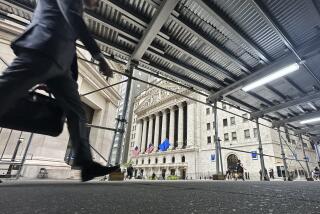Dow gains 32 points despite poor employment, foreclosure reports
- Share via
Wall Street breathed a sigh of relief Friday as most stocks rose in the face of a lousy August employment report and dismal mortgage foreclosure data.
After falling 150 points in the first two hours of the session, the Dow Jones industrial average recovered to finish up 32 points.
The government said payrolls shrank by 84,000 last month, more than the 75,000 economists had predicted and higher than the 51,000 jobs lost in July. The unemployment rate rose to a five-year high of 6.1% from 5.7%.
But the market’s reaction was muted, perhaps because investors got a lot out of their systems Thursday, when the Dow dived 344 points
Thursday’s blood bath returned all three major stock indexes to bear-market territory, defined as a 20% drop from a recent peak.
On Friday, despite its initial decline, the Dow held above its summer closing low of 10,962, reached on July 15, which may have helped boost sentiment once prices turned up. That recovery was probably intensified by so-called short covering as traders closed out bearish bets, said Brian Rauscher, director of portfolio strategy at Brown Brothers Harriman.
The Dow on Friday rose 32.73 points, or 0.3%, to 11,220.96. Broader indexes were mixed. The Standard & Poor’s 500 index climbed 5.48 points, or 0.4%, to 1,242.31, and the Nasdaq composite index fell 3.16 points, or 0.1%, to 2,255.88.
Advancing issues narrowly outnumbered decliners on the New York Stock Exchange.
Markets elsewhere didn’t fare as well -- continuing the pattern of the last few months -- amid fears that overseas economies may do worse than the U.S. A Bloomberg index of 500 European blue-chip stocks slumped 2.2% after sliding 2.5% on Thursday. It’s down 26% year to date, compared with a 16% decline in the Dow.
Japan’s Nikkei 225 index lost 2.7% on Friday after falling 1% on Thursday, and is down 20% this year.
And in China, the Shanghai composite tumbled 3.3% to 2,202.45, leaving it down 64% from its record high last October.
In the U.S., investors will look next week to see which sectors might emerge as leaders.
Of the 10 industry groups in the S&P;, energy, utilities and raw materials are the worst performers this quarter, a complete reversal from the second quarter.
“It’s been such a turbulent market [that] it’s been hard to glean any sense of direction,” said Jack Ablin, chief investment officer of Harris Private Bank in Chicago. Will defensive sectors such as utilities and materials resume leadership “or will it be more quality growth, optimistic sectors like technology and healthcare?”
In other market highlights:
* Financial stocks in the S&P; 500 surged 3.3%, more than any other broad industry group. Fannie Mae and Freddie Mac sank in after-hours trading on reports that the Treasury was preparing to take them over. Such a move could wipe out existing shareholders.
* Oil futures fell $1.66 to $106.23 a barrel on the New York Mercantile Exchange.
* For the week, the Dow lost 2.8%, its fourth straight week of losses and the biggest drop since late June. The S&P; 500 gave up 3.2% and the technology-heavy Nasdaq, home to many stocks seen as riskier than the blue chips, fell 4.7%.
--
The Associated Press was used in compiling this report.
More to Read
Inside the business of entertainment
The Wide Shot brings you news, analysis and insights on everything from streaming wars to production — and what it all means for the future.
You may occasionally receive promotional content from the Los Angeles Times.










